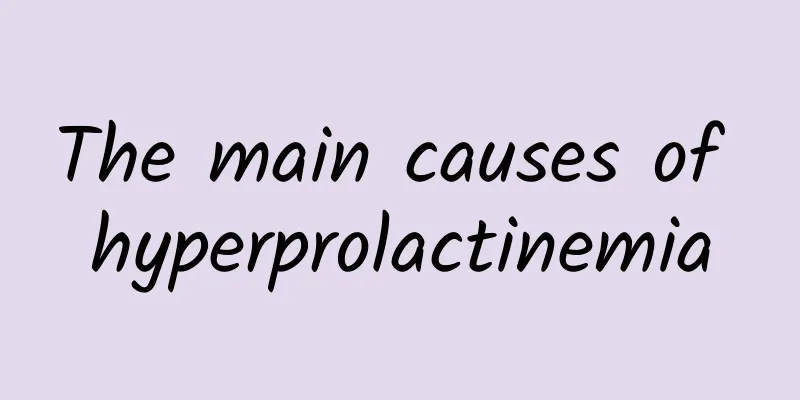The main causes of hyperprolactinemia

|
Hyperprolactinemia can be divided into physiological and pathological. The former is a normal phenomenon and does not harm the patient; the latter refers to the abnormal increase of prolactin, which is harmful to the patient. So, what causes this disease? Please see the following introduction for details. 1. Causes of disease 1. Physiological hyperprolactinemia Normal healthy women have elevated plasma prolactin levels at night and during sleep (2-6am), in the late follicular phase, and in the luteal phase. Plasma prolactin levels increase 5-10 times during pregnancy. Prolactin concentrations in amniotic fluid are higher than in plasma after the second trimester of pregnancy. In lactating women, plasma prolactin concentrations are 1 times higher than in the non-pregnant period. Plasma prolactin levels in fetuses and newborns (≥28 weeks of gestation to 2-3 weeks postpartum) are equivalent to maternal levels. Breast massage and nipple sucking reflexively promote prolactin secretion. Plasma prolactin levels remain high during the puerperium (within 4 weeks). Prolactin levels in non-lactating women drop to non-pregnant levels within 3 months. Prolactin levels increase significantly during fasting, insulin-induced hypoglycemia, exercise, stress, and sexual intercourse. 2. Pathological hyperprolactinemia (1) Hypothalamic-pituitary lesions: ① Non-functional hypothalamic tumors: including craniopharyngioma, invasive hypothalamic lesions sarcoid disease, histiocytosis, glioma and leukemia. ② Functional pituitary tumors: including pituitary adenoma (80% secrete prolactin), prolactin adenoma, acromegaly (25% accompanied by hyperprolactinemia), Cushing's syndrome (adrenal ACTH adenoma, 10% accompanied by hyperprolactinemia), and prolactin cell hyperplasia (80% accompanied by hyperprolactinemia). ③ Functional hyperprolactinemia: caused by dopamine function inhibition, including primary vacuolar sella syndrome (5% accompanied by amenorrhea and galactorrhea syndrome) and secondary vacuolar sella syndrome (10% accompanied by hyperprolactinemia). ④ Inflammatory and destructive lesions: including meningitis, tuberculosis, syphilis, actinomycosis, injury, surgery, arteriovenous malformation, granulomatous disease; pituitary stalk lesions, injury or tumor compression. ⑤Mental trauma, stress and Parkinson's disease. (2) Thyroid and adrenal diseases: including primary and secondary hypothyroidism, pseudohypoparathyroidism, Hashimoto's thyroiditis. Adrenal diseases, including chronic kidney disease, Addison's disease, and chronic renal failure, may cause hyperprolactinemia. (3) Ectopic prolactin secretion syndrome: including undifferentiated bronchial lung cancer, adrenal cancer and embryonal carcinoma. (4) Polycystic ovary syndrome. (5) Gynecological surgery and local stimulation: including artificial abortion, invasive hydatidiform mole or stillbirth, hysterectomy, tubal ligation, and oophorectomy. Local stimulation of the breast, including papillitis, fissures, chest wall trauma, herpes zoster, tuberculosis, and chest wall surgery, can also reflexively cause hyperprolactinemia. |
<<: Comprehensive understanding of the causes of hyperprolactinemia in women
>>: What are the causes of physiological hyperprolactinemia?
Recommend
What are the disadvantages of taking ibuprofen during menstruation? Inducing endocrine disorders
Ibuprofen is a hormone drug and is not suitable f...
How much does it cost to cure pelvic peritonitis?
Pelvic peritonitis refers to inflammation of the ...
Do uterine fibroids require surgery? Under what circumstances do uterine fibroids require surgery?
Do uterine fibroids need to be surgically removed...
To lose weight, you need to supplement with high-quality protein! Mexican-style salad without gaining weight
If you want to have beautiful curves, it is very ...
The recurrence of uterine fibroids is mainly caused by the following reasons
Recurrence of uterine fibroids is a common phenom...
Four ways to help you get rid of cervicitis
Cervicitis is a common gynecological disease. It ...
What to eat for dysfunctional uterine bleeding? Recommend these 6 diets
Patients with dysfunctional uterine bleeding can ...
How to care during the treatment of premature ovarian failure?
In life, for gynecological diseases such as prema...
The dangers of progesterone inducing menstruation
Using progesterone to induce menstruation may bri...
5 typical symptoms of ectopic pregnancy
Ectopic pregnancy refers to the fertilized egg be...
Yunlin sampled 13 ice cream and cold drinks that did not comply with regulations
Eating ice cream in the summer is refreshing and ...
Multiple methods of testing for hyperprolactinemia
What are the examination methods for hyperprolact...
Are uterine fibroids serious? Who are the high-risk groups for uterine fibroids?
Uterine fibroids, also known as uterine leiomyoma...
Secret recipe for quick weight loss! Jennifer Aniston eating pureed vegetables
Recently in the popular Hollywood comedy "Mc...
Can I have an abortion if I have uterine fibroids?
In life, many female friends do not take preventi...









